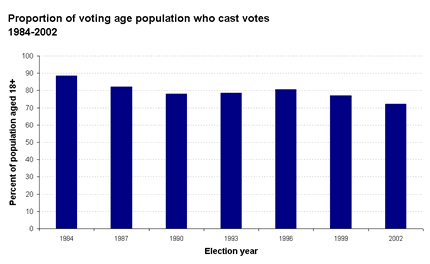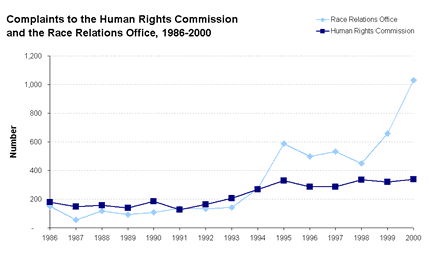Civil, Political and Human Rights
OUTCOMES
Civil and political rights, as well as economic, social, and cultural rights, are enjoyed by all. The principles of the Treaty of Waitangi are upheld and incorporated into government decision-making.
INTRODUCTION
Underpinning this report is the notion that certain basic conditions need to be satisfied in order for people to be able to achieve an adequate standard of living, fulfil their own potential and generally be able to live the kind of life that they value. These basic conditions include human rights to protect people from discrimination and inequality, and a legal framework to allow all people to participate in civil, political, economic, social and cultural life.
The principal aim of human rights is to protect the dignity of individuals whatever their status or circumstances. Human rights require not only that citizens are protected from abuse of power by governments but also that governments organise society in a way that enables all individuals to develop to their full potential.
New Zealand is signatory to the six core United Nations treaties on various aspects of human rights. These include: the International Covenant on Civil and Political Rights; the International Covenant on Economic, Social and Cultural Rights; the International Convention on the Elimination of all Forms of Racial Discrimination; the Convention on the Elimination of Discrimination against Women; the United Nations Convention on the Rights of the Child; and the Convention Against Torture and Other Cruel, Inhuman or Degrading Treatment or Punishment. New Zealand reports regularly to the United Nations, is monitored internationally, and enjoys a good reputation for its protection of human rights.
As well as these international treaties, the Treaty of Waitangi has a unique place in New Zealand society. It underpins the relationship between Māori (as the indigenous people of New Zealand ) and the British Crown (now represented by the Government of New Zealand ). The process of providing compensation for past grievances can be seen as a symbol of Crown and society's commitment to righting past wrongs and creating a society fully inclusive of Māori. The compensation process is also an important and tangible mechanism for contributing to future Māori social, economic and cultural development.
Increasing recognition of the importance of the principles of the Treaty of Waitangi in relation to public policymaking also has important benefits for Māori participation in society and for Māori developmental aspirations. The role of the Treaty of Waitangi in wider society, however, has been the subject of much discussion in recent years and is a matter of ongoing debate.
Other important legislative examples include the Privacy Act and the New Zealand Bill of Rights Act which also form part of a framework to ensure basic rights.
Establishing and reporting on the legislative human rights framework of a country is only one way of measuring its commitment to eliminating inequality, discrimination and barriers to full participation by all its citizens. The indicators in this chapter give some measure of how our formal commitment to civil, political and human rights is reflected in reality.
One of the key principles of democracy is the right to vote in free and fair elections by secret ballot. Political participation, defined here in terms of voting in national elections, is a measure of trust and confidence in the political institutions that help shape citizens' lives. High voluntary voter turnout rates are an indication that people see these institutions as relevant and meaningful to them.
Measuring the extent to which New Zealanders actually experience discrimination is more problematic. Some research has suggested that for every 100 people who are discriminated against, only one will make a complaint. In addition, a significant number of complaints are made by people who feel disadvantaged by policies they see as providing an unfair advantage to certain groups. It is important, however, to try to get some direct measures of the extent of discrimination in our society. A recent survey, for example, found that up to three-quarters of people believe there is still some or a great deal of discrimination against a range of groups, in conflict with our image as a fair and just society . This chapter reports on the number of complaints to the Human Rights Commission and the Office of the Race Relations Conciliator although it is recognised that these are imperfect measures and changes over time can be difficult to interpret.
KEY POINTS
- Voter turnout has declined from 88 per cent in 1984 to 72 per cent in 2002. Similar declines have been occurring in other OECD countries and New Zealand's voter turnout rate is still high compared with rates in other Western democracies.
- More complaints are being reported to the Human Rights Commission (HRC) and the Race Relations Office (RRO). Complaints to the HRC today are twice the levels typically found in the mid-1980s, while complaints to the RRO are at five times the mid-1980 levels. Most commonly, complaints relate to discrimination in employment on the grounds of disability and race, being denied access to goods and services because of one's race, and sexual harassment.
SUMMARY
Declines in voter participation may be associated with decreased levels of trust in political institutions as well as dissatisfaction with increasingly disproportional electoral outcomes.
Non-voters are more likely to be Māori or Pacific peoples, to have lower incomes and to be younger. There are few differences in voting turnout rates between men and women.
The increase in the number of human rights and race relations complaints needs to be viewed in the context of legal changes that have broadened the possible areas for complaint over the years. Problems related to under-reporting of discrimination also need to be considered.
Voter turnout
DEFINITION
The number of persons who cast valid votes in general elections from 1984 to 1999 as a percentage of the people who were eligible to vote (and aged 18 and over).
RELEVANCE
Voter turnout rates are a measure of political participation. They can be seen as an indicator of the extent to which citizens feel part of the political process, and are an indication of the level of trust in political institutions.
CURRENT LEVEL AND TRENDS
Voter turnout among the eligible population was 72.4 per cent in 2002. Voter participation in general elections declined sharply from 89 per cent in 1984 to 78 per cent in 1990, increased slightly to 81 percent in 1996, then declined again to a new low in 2002.

Source: Electoral Commission 2002, Electoral Commission 2000, p.141. 1984 figure calculated by Ministry of Social Policy
COMPARISONS BETWEEN GROUPS
Because of the nature of the secret ballot, information on differences in participation rates among various sectors of the New Zealand population is not directly available. Nevertheless, results from several New Zealand Election Surveys over a number of years associate a number of social, demographic, and occupational characteristics with impacts on the voter turnout rate. Non-voters are more likely to be people on lower incomes, younger people, and members of Māori or Pacific ethnic groups. There are few differences in voting turnout rates between men and women.
REGIONAL DIFFERENCES
There are few discernible differences in voting turnout rates between rural and urban voters, although non-voting tends to be lowest in provincial cities.
INTERNATIONAL COMPARISON
New Zealand's voting turnout is considered high when compared with other Western democracies. In line with political participation trends in other OECD countries, voter turnout in New Zealand has been declining slowly.
Complaints to the Human Rights Commission and Race Relations Office
DEFINITION
The annual number of complaints made to the Human Rights Commission and to the Race Relations Office from 1984 to 2000.
RELEVANCE
Charting the numbers of complaints made to the Human Rights Commission (HRC) and to the Race Relations Office (RRO) is one indication of the levels and types of discrimination in New Zealand . It is one measure of whether all New Zealanders enjoy equal opportunities and of the extent to which differences in a pluralist society are recognised and respected.
CURRENT LEVEL AND TRENDS
In the year to June 2000, 337 complaints were made to the Human Rights Commission and 1,031 to the Race Relations Office. This represents a 12 per cent increase and a 56 per cent increase on the 1999 levels respectively.
The more modest rises in discrimination complaints to the HRC may be partly attributable to changes in legislation and reporting requirements. Before 1978, it was lawful to discriminate on the basis of sex, marital status and religious belief. Before 1992, it was lawful to discriminate on the basis of age while before 1994, it was lawful to discriminate on the basis of disability, sexual orientation, political opinion, employment status or family status.

COMPARISONS BETWEEN GROUPS
Disability complaints to the HRC are now the single largest category of complaints (28 per cent), and half of these relate to employment.
Sexual harassment was the second largest category both in 2000 (18 per cent) and 1999 (24 per cent). Age discrimination was the third largest category both in 2000 (14 per cent) and 1999 (13 per cent).
Table CP2.1: Percentage share of complaints to the Human Rights Commission (HRC) by discrimination type
| Year | 1985 | 1990 | 1995 | 2000 |
| Type of complaint | % (n) | % (n) | % (n) | % (n) |
| Disability | 20 (67) | 28 (94) | ||
| Sex (up to 1994) | 45 (91) | 81 (150) | ||
| Sexual harassment (from 1995) | 12 (40) | 18 (61) | ||
| Age (from 1992) | 14 (45) | 14 (46) | ||
| Gender (from 1995) | 18 (59) | 11 (39) | ||
| Employment status | 3 (11) | 10 (35) | ||
| Family/marital status | 6 (13) | 18 (34) | 20 (64) | 9 (30) |
| Religious belief | (7) | 0.5 (1) | 3 (11) | 4 (12) |
| Sexual orientation | 1 (3) | 3(11) | ||
| Other | 45 (90) | 0.5 (1) | 9 (29) | 3 (11) |
| Total number of complaints to the HRC | 201 | 186 | 329 | 337 |
The majority of complaints to the Race Relations Office in 1999 concerned racial harassment (22 per cent) and racial disharmony (15 per cent), discrimination in the provision of goods and services (19 per cent) and in employment (15 per cent). Over two-thirds of complaints have fallen into these four categories for the past three years.
Table CP2.2: Percentage share of complaints to the Race Relations Office (RRO) by discrimination area
| Year | 1985 | 1990 | 1995 | 1999 |
| Complaint area | % (n) | % (n) | % (n) | % (n) |
| Racial harassment (classified with "Racial disharmony" until 1994) | 21 (122) | 22 (145) | ||
| Racial disharmony | 76 (141) | 42 (45) | 40 (235) | 15 (98) |
| Provision of goods and services | 4 (8) | 7 (8) | 10 (60) | 19 (122) |
| Employment | 6 (12) | 36 (39) | 8 (46) | 15 (101) |
| Educational institutions (from 1994) | 3 (18) | 3 (21) | ||
| Advertising | 2 (3) | 4 (4) | 5 (31) | 2 (16) |
| Housing, accommodation | 9 (16) | 5 (5) | 5 (27) | 2 (16) |
| Access to public places | 3 (5) | 6 (6) | 3 (16) | 0 (0) |
| Other | 0 (0) | 0 (0) | 5 (32) | 19 (123) |
| Total number of complaints to the RRO | 185 | 107 | 587 | 658 |
